Where are we today? We’re at our neighbors to the west, Chile. It’s a very long country north to south, but a very narrow one east to west, and runs along the Pacific coast of South America, from its southernmost tip to where it meets up with Peru – most of its eastern border is with Argentina, only a small section in the north bordering on Bolivia. In total it encompasses a little over 1/4 million square miles, or just a bit bigger than Texas, but with only about 60% of the population, coming in at around 17.6 million.  But, it’s north to south length is 2700 miles, or roughly the distance from the east to west coast of the US, while its width is only 110 miles on average. The capital, Santiago, almost straight west of where I’m sitting in Buenos Aires, roughly 890 miles away.
But, it’s north to south length is 2700 miles, or roughly the distance from the east to west coast of the US, while its width is only 110 miles on average. The capital, Santiago, almost straight west of where I’m sitting in Buenos Aires, roughly 890 miles away.
Ethnically, the population are roughly 52% of European descent, 44% indigenous, and 4% African, but that’s in genetic makeup – 90 some percent are a mestizo of those stretching back to the era of Spanish colonization in the 16th century. Surprisingly for a Latin American country, the population is only 45% Catholic, with only another 18% being other flavors of Christianity, leaving over 1/3 of the population identifying as other, or no, religion. Not surprisingly, the cuisine, which is where we’ll head now, is a blend of indigenous ingredients and dishes with Spanish ones.
The bread end of this venture was an easy decision, returning to my original proposition of “empanada-like things”, which I’ve strayed a long way from in various posts, having, to my chagrin and surprise, discovered that there isn’t actually an empanada-like thing in many cuisines. But Chile, as with most South American countries, loves its empanadas, and the classic of the country is the Empanada de Pino. Now, literally, that seems like it translates to the “pine empanada”, but there’s no pine in it, nor anything treelike about it. The word pino in this case is a Spanish-ization of the indigenous Mapuche word pirru, which refers to a mixture of meat and onions.
The soup really came down to a whim among the four most famed of Chile’s soups: the carbonada chilena, a mildly spiced stew of beef, potatoes, pumpkin, and corn; the paila marina, a shellfish soup heavily flavored with paprika and parsley; the caldillo de congrio, a sort of fish chowder (and one you’ve seen several times in these pages over the years); and, the Valdiviano, a soup that was created by the soldiers around the Valdivia area of Chile during the conquistador era as a way of using dried beef rations and local ingredients to make the former more palatable. The first three are either ones I’ve made before or just didn’t present any sense of exploration of something new for me. Making a soup out of charqui, dried beef, while akin to the biltong soup I made for Burundi, is quite different.
The empanada dough – a simple mix of 2½ cups of pastry flour, ¾ teaspoon of salt, 4 tablespoons of lard, ½ cup of milk (actually, a splash or two more to get it to come together – variable depending on your flour), and the yolk of an egg. Save the egg white to use to brush on the surface of the empanadas to make them shine. Melt the lard, and mix all the ingredients together to form a slightly dry, but relatively smooth dough. Let it rest for about half an hour.
The empanada filling – 2 eggs (hard boil them), ½ pound of ground beef, a chopped medium onion, a dozen black olives (tradition is not to pit them, but I do, it’s a pet peeve, I hate biting into something and chomping down on an olive pit – I don’t think I’ve met an Argentine or Chilean how hasn’t chipped a tooth at some point doing this), 2 tablespoons of flour, a couple of tablespoons of raisins, and a mix of 2 teaspoons paprika (sweet and/or smoked), and ½ teaspoon each of salt, pepper, and cumin.
I’m going to trust that you can sauté some onions in a splash of oil, when they’re soft, add the beef and the spices, cook until brown, sprinkle with the flour and cook for a minute to toast the flour, add about 2 tablespoons of water which will bind it all together with that flour. Take it off the heat, stir in the raisins, and let it cool.
Divide the dough in six equal parts, roll them out into “rounds”, maybe 1/8 of an inch thick and about 6 inches across. Divide the filling between them, put a quarter of a hard boiled egg and two of the (pitted) olives atop. Wet the dough around the filling and fold the dough over and press to seal, then pleat it together to seal it or use a fork or whatever works for you, to make sure it’s well sealed and won’t just pop open while baking.
Put on a baking sheet, brush with the egg white, and pop them in a hot oven.
And, 15-20 minutes later, you’ll have beautiful empanadas de pino, all golden brown.
So, this needs to start a bit earlier, because we need to make our carne asada, an oven dried beef, which is what most people these days use in place of charqui, air dried salt beef. These are two small slices of roast beef, less than an inch thick, salted with coarse salt, put on a sheet tray, and…
…then into a medium heat oven for about an hour until well dried. I probably should have gone slightly lower temperature and longer time, because the idea isn’t to brown them, but just to cook them through and dry them. But hey, those caramelized bits are flavor! Let them cool and then shred them, which is a tedious process, but, part of the soup!
Here we have our shredded dried beef, a bell pepper cut in julienne, two onions also cut in julienne, or “plumes”, a large potato cut in chunks (tradition is to just sort of cut the potato into long wedges, but those are a pain to cook with and then eat, so I didn’t. So there. Four eggs, parsley, a lemon, and… 2 teaspoons each of sweet paprika and dry oregano, 1 teaspoon of cumin, and 1 teaspoon of merquén, the Chilean chili spice I’ve mentioned before – it’s a smoked, fairly hot dry chili. You’ll also need two liters/quarts of well flavored beef broth.
Let’s start with the eggs. Okay, this is not the traditional way they made this dish back in the era of the conquistadors. The really traditional way is to make the soup, ladle it into bowls that can go into the oven or directly over a flame, drop in an egg, and cook it until the white just sets but the yolk stays runny. I don’t really have bowls I feel like doing that to, so the options were pretty much either the modern common approach to just poaching or soft boiling the egg and then dropping it in, or, sous vide them to the same doneness.
Skipping steps in the photos – a knob of butter or lard, and toss in the onions and peppers. Cook for about five minutes over medium heat. Add the beef and the spices and cook another five minutes to toast the spices.
Add the potatoes and the broth, bring to a boil, reduce the heat, and cook about fifteen minutes until the potatoes are cooked through.
Add the chopped parsley and the juice of the lemon. Taste, adjust salt if need be, and you’re ready to either ladle them into your flameproof bowls and drop an egg in, or just into bowls and crack in a sous vide or soft boiled egg, or drop in a poached one.
And, there you have it our empanada de pino and valdiviano. I loved this one, as did my lunch guest. It’s a delicious, hearty, cold weather soup (and we’re moving into our cold weather months). I especially like the different texture, and flavor, that the dried beef gives this – it’s just something unusual and different, and made this not just another beef, onion, and potato stew. For me, the empanadas could use a little more zing to them – I think I’d go half and half between smoked and hot paprika in the ingredients on a future remake. It may not be as traditional – though I have seen some recipes that even use merquén, which is a lot spicier than hot paprika. Or, serve them with pebre, Chile’s national hot sauce, very similar to a Mexican pico de gallo, except with parsley rather than cilantro.
Next stop… China. Oh boy, the first really big, hugely varied country to hit. How I’m going to even begin to narrow down a representative soup and bun, I have no idea.
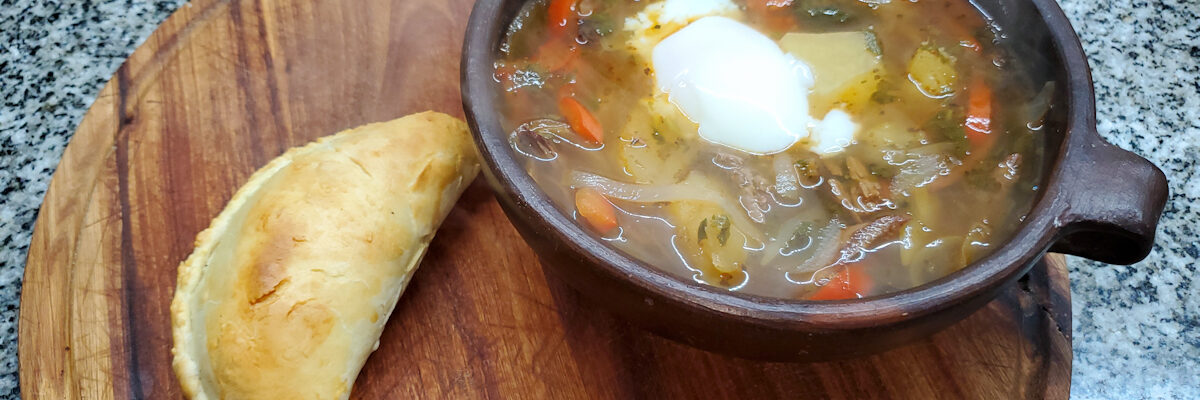
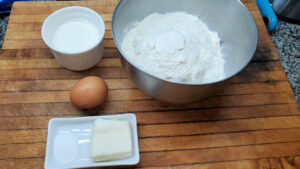
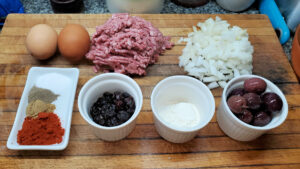
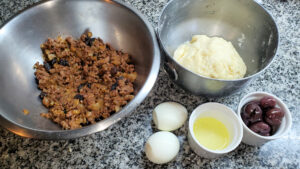
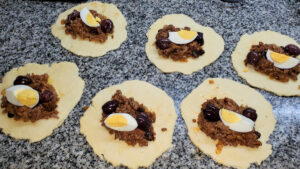
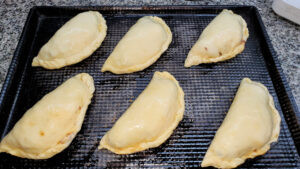
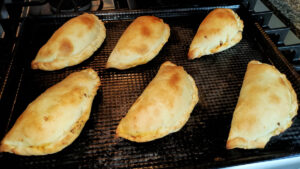
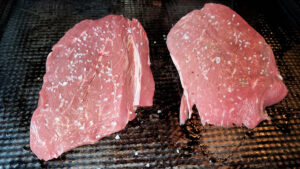
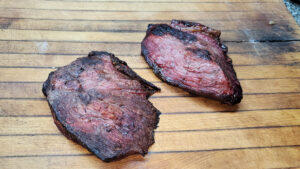
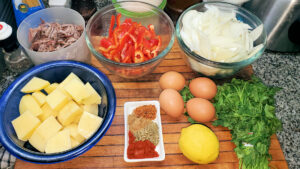
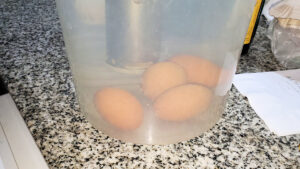
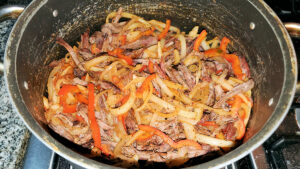
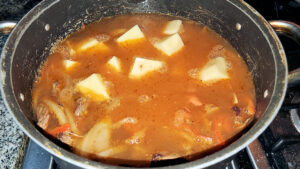
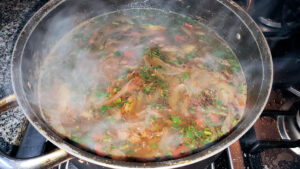
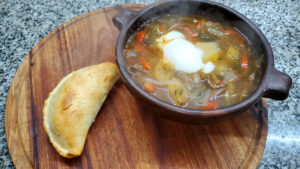
[…] Next time, a bit closer to home, as we head to Chile! […]